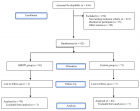Previous Issue (Volume - 7 | Issue - 1)
A challenging case of cutaneous sarcoidosis with unusual findings in a Syrian woman: a case report and review of literature
Published on: 14th March, 2023
Sarcoidosis is a granulomatous disease that involves multiple systems. Cutaneous involvement can manifest in patients with sarcoidosis and can present with or without systemic involvement. We present a case of cutaneous sarcoidosis in a Syrian woman that showed improvement after a combination of methotrexate and prednisolone therapy. The patient had unusual chest radiography findings and developed an unexplained fissured tongue after 5 days of receiving methotrexate therapy. In addition, the patient developed indurated erythematous plaque and papules on her upper right arm at the same location as a performed biopsy, which increased the diagnosis of a newly formed scar sarcoidosis although she was receiving her treatment.
Coronary artery anomalies, myocardial bridging associated with fistula to pulmonary artery trunk. Case reports
Published on: 31st March, 2023
Between coronary artery anomalies, myocardial bridging means an epicardial coronary artery, mostly left anterior descending artery (LAD), running through an intramyocardial “tunnel” (usually in the middle segment), leading during systolic contraction, flow reduction, through the vessel. When this anomaly is associated with a coronary fistula, which “steals” more from the bloodstream, the symptoms are more pronounced, and the management complex is surgical in particular. Despite the presence from birth remains asymptomatic and it becomes clinically manifest later in the third to fourth decade of life, with a diverse palette of symptoms; angina, arrhythmias, and acute myocardial infarction up to sudden death. Diagnosis and particular management, medical, interventional, and surgical should avoid major cardiac complications and sudden death. We present two adult patients, with coronary artery bridging, one case associated with coronary artery fistula, LAD to pulmonary artery trunk, very symptomatic with surgical management, and the second only myocardial bridging controlled with medication and supervision.
Subcorneal pustular dermatosis (Sneddon-Wilkinson disease): a case report
Published on: 5th April, 2023
This article contains modern data on the etiology, clinical presentation and treatment as well as the differential diagnosis of a rare dermatosis, Sneddon-Wilkinson disease.Clinical observation of subcorneal pustular dermatosis in a 68-year-old woman is reported. Histopathological examination played a key role in making the correct diagnosis. Treatment consisted of a physiotherapeutic approach (311 nm UVB phototherapy) in combination with systemic glucocorticosteroids (dexamethasone). This therapeutic approach (instead of dapsone therapy) can be used due to its relatively good safety profile.
An Urticaria Closet Simulating Leprosy in A 36-Year-Old Woman
Published on: 24th June, 2023
Urticaria corresponds to a papular edematous pruriginous fleeting rash on the skin whose cause is most often allergic (food, medicines, insect bites, etc.).Its management is often difficult because of its significant impact on quality of life. Its prevalence is estimated at 0.6% - 1.3% of the general population. Leprosy is a chronic infectious disease caused by Mycobacterium leprae (M. leprae) or Hansen’s bacillus (BH). Considered as the great simulator leprosy can pose a diagnostic problem with many other dermatological pathologies. This is a 36-year-old patient with a history of chronic urticaria treated with Loratadine 10 mg who consulted the Bamako Dermatology Hospital for a large erythematous cupboard, oedematous fixed on the buttocks evolving for more than 3 days. The interrogation found the notion of pruritus, hives, and physical examination, showed large erythematous plaques, edematous very limited, dark red color, and slightly copper resembling the closet infiltrated by leprosy. The pruriginous nature of the lesions and the absence of other cardinal signs of leprosy allowed us to make the diagnosis of chronic urticaria.
The Combinatory Effects of Zinc Oxide Nanoparticles (ZnO NPs) and Thiamine on Skin of Alloxan-Induced Diabetic Mice; a Stereological and Biochemical Study
Published on: 3rd July, 2023
This study aimed to investigate the treatment effects of ZnO NPs plus thiamine on histo-stereological and biochemical parameters in diabetic mouse skin. In total 54 BALB/C mice were used and divided into nine groups. Twenty-four mice were coordinately assigned as control groups (I), thiamine (II), and zinc oxide nanoparticles (III and IV; 1.0 and 5.0 mg/kg). Diabetes was induced in the remaining rats with a dose of 180 mg/kg of alloxan; diabetes group (group V). Other diabetic mice were treated with ZnO NPs (0.1 and 0.5 mg/kg) alone (groups VI and VII, respectively) and along with thiamine (groups VIII and IX, respectively). An increase in weight was observed in the diabetic group compared to the control group. Diabetic skin showed decreasing in volume density of collagen bundles and decreasing in the epidermis and dermis thickness, as well as an increase in the hypodermis's thickness. Administration of ZnO NPs (0.1 and 0.5 mg/kg) alone and along with thiamine in the diabetic animals resulted in anti-hyperglycemic activity, reducing GGT, BUN, Cr, MDA, and NO levels in treated diabetic mice. In conclusion, the concomitant use of ZnO NPs along with thiamine presents the potential as a combination therapy for the treatment of alloxan-induced diabetic mice skin changes.
Case Report of Gardner-Diamond Syndrome
Published on: 25th July, 2023
Gardner-Diamond syndrome or psychogenic purpura is a rare vasculopathy disorder characterized by spontaneous painful purpuric rash without a history of trauma or antiplatelet or anticoagulant therapy. It occurs in women with mental health disorders. Gardner and Diamond in 1955 described a syndrome of auto erythrocyte sensitization which presented in abnormal crops of painful inflammatory ecchymosis in 4 patients at the site of trauma followed by progressive erythema and edema.
We present a 52-year-old age woman who was admitted to the internal medicine department and referred for dermatological consultation for recurrent spontaneous purpuric eruptions. The patient was under treatment for depression for many months. Her investigations and coagulation profile were nearly within normal.
Rare Presentation of Chromoblastomycosis Due to Multiple Simultaneous Inoculations: A Case Report
Published on: 7th August, 2023
Chronic infectious, granulomatous and suppurative dermatosis, classified among the subcutaneous mycoses, prevalent in tropical and subtropical regions and caused by the traumatic implantation of dematiaceous fungal species, where the presence of muriform bodies is an expression of the causal agent in the grafted tissue, are characteristic of chromoblastomycosis. Considered the second implantation mycosis in the world, it manifests itself with slow and progressive growth lesions of exophytic and verrucous plaques and black dots on the surface.The disease is considered a neglected and occupational disease, which occurs mainly among agricultural workers, coconut and babassu harvesters, lumberjacks, and traders of agricultural products. It is important to highlight that people at risk of contracting chromoblastomycosis work in tropical countries, where the temperature can be above 40 °C in summer, and generally refuse to wear protective equipment during the day (shoes, gloves, clothes, etc.), although they know that this type of prophylactic measure can prevent different types of diseases. These vulnerable people often live in low-income countries and sometimes live far from medical services and, once infected, do not seek medical attention. We report below an exuberant and unusual case due to multiple simultaneous inoculations on the back after the patient suffered an accidental fall while working on his farm. The diagnosis was established by direct mycological examination, histopathological examination, culture, microculture, and MALDI-TOF MS analysis that identified the agent of the Fonsecaea pedrosoi.
Epidemiological and Clinical Aspects of Staphylin Dermatitis: A Study of 30 Cases at the Dermatology Hospital in Bamako
Published on: 15th December, 2023
Staphylin dermatitis is an acute, irritant, contact dermatitis caused by Pederin, a haemolymphatic fluid released when staphilinidae are crushed against the skin [1]. This is a serious condition, with epidemics and certain localizations, especially in the eyes, which can lead to blindness.

HSPI: We're glad you're here. Please click "create a new Query" if you are a new visitor to our website and need further information from us.
If you are already a member of our network and need to keep track of any developments regarding a question you have already submitted, click "take me to my Query."


















































































































































